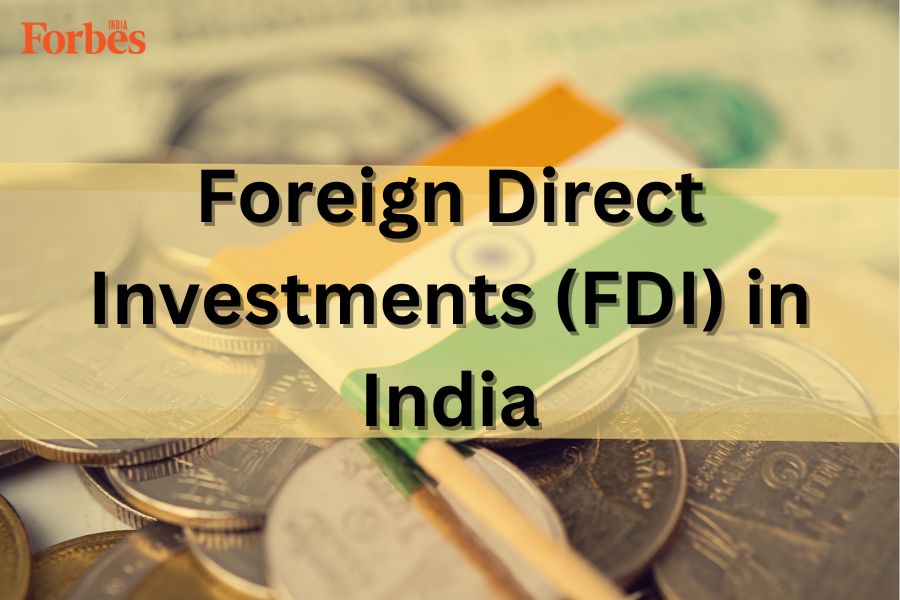
Foreign Direct Investment (FDI) is a pivotal driver of economic growth, fostering development and innovation worldwide. Likewise, FDI in India plays an instrumental role in shaping the country’s economic landscape.
As per the United Nations Conference on Trade and Development (UNCTAD) World Investment Report 2024, there was 43 percent decrease in FDI in India in 2023. Global FDI flows fell 2 percent to $1.3 trillion in 2023, as trade and geopolitical tensions weighed on a slowing global economy, said the report. Geopolitical crises, protectionist policies and regional realignments are disrupting the world economy, fragmenting trade networks, regulatory environments and global supply chains, according to the report. This undermines the stability and predictability of global investment flows, creating both obstacles and isolated opportunities.
In this post, we discuss the significance of FDI in India in detail.
FDI regulations in India
India offers an automatic route for FDI in several sectors, simplifying the investment process for foreign investors in India. However, certain sectors require government approval, and FDI caps and conditions vary from one industry to another. Strict reporting requirements, in line with the Foreign Exchange Management Act (FEMA), are in place to ensure transparency in foreign investments in India.
Government bodies regulating FDI
FDI in India are subject to regulation and oversight by various government bodies, such as
- Department for Promotion of Industry and Internal Trade (DPIIT)- DPIIT formulates and implements policies to promote and regulate foreign investment in India across sectors.
- Reserve Bank of India (RBI)- RBI manages the monetary aspects of foreign investments in India.
- Securities and Exchange Board of India (SEBI)- SEBI regulates FDI in the capital market.
Key policy changes and reforms
The Startup India program offers incentives and tax benefits to startups, helping in their momentous growth. This makes the tech and innovation sector an appealing investment for foreign investors in India. Moreover, simplified processes, like single-window clearance and the Goods and Services Tax (GST) implementation, have eased the bureaucratic burden on businesses and foreign investors in India, thereby enhancing the ease of business in the country.
FDI routes in India
There are two FDI routes in India designed to safeguard India’s security and national interests. The government employs these routes as a means to promote foreign investment in India in particular sectors, and these FDI routes in India also empower foreign investors in India to choose the pathway that aligns with their business objectives and ensures compliance with India’s regulations.
Automatic route
The automatic route allows foreign investors in India to invest in sectors without requiring prior approval from Indian authorities. Under this route, investors are only required to notify the Reserve Bank of India (RBI) within a specified time frame. This route is designed to promote ease of doing business and attract foreign capital, making it particularly attractive for sectors open to higher FDI limits or do not have specific security concerns.
Government route
The government route necessitates prior approval from the Indian government or relevant ministries for foreign investors in India. This route is typically reserved for sectors that involve national security, strategic interests, or have specific regulatory concerns. This route helps the government maintain control over sensitive areas of the economy while still allowing foreign investments in India on a case-by-case basis.
FDI in India inflows over the last ten years
The table below provides the FDI in India inflows over the past decade, with data sourced from UNCTAD.
| Financial year (April-March) | Total FDI inflow (US $) | % of GDP |
|---|---|---|
| 2013 | 28.19B | 1.52% |
| 2014 | 34.58B | 1.70% |
| 2015 | 44.06B | 2.09% |
| 2016 | 44.48B | 1.94% |
| 2017 | 39.90B | 1.51% |
| 2018 | 42.15B | 1.56% |
| 2019 | 50.55B | 1.78% |
| 2020 | 64.07B | 2.41% |
| 2021 | 44.73B | 1.42% |
| 2022 | 49.35B | 1.47% |
| 2023 | 28.16B | 0.71% |
Factors affecting FDI inflows
Factors influencing FDI inflows are essential considerations for any nation seeking to attract and optimise foreign capital. The key factors affecting inflows of foreign investments in India include-
- Economic stability
- Regulatory environment
- Sectoral policies
- Political stability
- Infrastructure
Sector-specific conditions, and limits
The approach to FDI in India is diverse. Let’s look at the sector-specific conditions and limits for FDI in India:
Allowed sectors and FDI limits
By allowing foreign investments in India in specific areas, the government aims to attract capital, expertise, and innovation while bolstering economic competitiveness and reducing import dependency. The table below shows the FDI limit for various sectors along with FDI routes in India, with data sourced from Make In India.
| Sector | FDI limit | Entry Route |
|---|---|---|
| Banking- Public | 20% | Government |
| Banking- Private | 74% | 49%- Automatic. Above 49-74%- Government |
| Insurance | 74% | Automatic |
| Asset Reconstruction Companies | 100% | Automatic |
| Credit Information Companies | 100% | Automatic |
| White Label ATMs | 100% | Automatic |
| Pension sector | 49% | Automatic |
| Agriculture & Animal Husbandry | 100% | Automatic |
| Plantation sector | 100% | Automatic |
| Mining | 100% | Automatic |
| Petroleum & Natural gas refining | 100% | Automatic |
| Defence manufacturing | 100% | Automatic upto 49%. Above 49% under Government route. |
| Broadcasting teleports | 100% | Automatic |
| Broadcasting content services | 49% | Government |
| Print media, dealing with news | 26% | Government |
| Publishing/printing of scientific and technical magazines/specialty journals | 100% | Government |
| Civil aviation- Airports | 100% | Automatic |
| Civil aviation- Air transport services | 100% | Automatic up to 49% Above 49% under Government route. |
| Telecom | 100% | 49%- Automatic. Above 49%- Government |
| Railways | 100% | Automatic |
| Financial services’ activities regulated by RBI, SEBI, IRDAI, other regulator | 100% | Automatic |
| Pharmaceuticals (Greenfield) | 100% | Automatic |
| Pharmaceuticals (Brownfield) | 100% | Automatic upto 74%, above 74% under Government |
| Power exchanges | 49% | Automatic |
| Construction development | 100% | Automatic |
| Industrial parks | 100% | Automatic |
| Satellites | 100% | Government |
| E-commerce activities | 100% | Automatic |
| Private security agencies | 74% | Automatic up to 49%. Above 49%- 74% under Government |
| Single brand retail trading | 100% | Automatic up to 49%. Above 49% under Government |
| Multi-brand retail trading | 51% | Government |
| Duty-free shops | 100% | Automatic |
| Food products manufactured or produced in India | 100% | Government |
| Cash & carry wholesale trading | 100% | Automatic |
| Biotechnology | 100% | Automatic |
| Electricals machinery and system | 100% | Automatic |
| Food processing | 100% | Automatic |
| Ports and shipping | 100% | Automatic |
| Textiles and garments | 100% | Automatic |
| Tourism and hospitality | 100% | Automatic |
Sectors where FDI is not allowed
Certain sectors are not permitted to receive FDI in India due to a range of reasons, including national security concerns, safeguarding domestic interests, and protecting small and medium-sized enterprises (SMEs). These sectors are listed below with data once again sourced from Make In India.
- Lottery business including Government/private lottery, online lotteries, etc.
- Chit funds
- Trading in Transferable Development Rights (TDR)
- Manufacturing cigars, cheroots, cigarillos and cigarettes, and tobacco substitutes
- Gambling and betting, including casinos
- Nidhi company
- Real estate business or construction of farmhouses
- Sectors not open to private sector investment- atomic energy, railway operations (other than permitted activities mentioned under the Consolidated FDI policy)
Notable foreign investments in India in crucial companies
In the past decade, there has been a constant influx of FDI in India. Foreign investors in India have practically invested in every sector, including pharmaceuticals, automobiles, textiles, and railways. FDI in India has led to advancements in infrastructure, job creation, increased exports, and substantial support for the formal sector.Here are a few noteworthy instances of recent foreign investments in India-
- In July 2023, Walt Disney explored various strategies to help its Star India business grow and reduce expenses, which may involve a joint venture or sale.
- In July 2023, Havas’s Indian arm, a French advertising and public relations company, declared its acquisition of PivotRoots.
- In June 2023, Private equity investors, including Blackstone Inc., BPEA EQT, CVC Capital Partners, and General Atlantic Service Company, were competing to acquire Mumbai-based Indira IVF Hospital Pvt. Ltd.
- In February 2023, Singapore Airlines purchased a 25.1 percent stake in the Air India group for $267 million.
- In January 2023, the rural economy-focused technology startup VilCart secured $18 million in funding from Asia Impact SA, Nabventures Fund, and Texterity Pvt Ltd to expand its operations.
- In December 2022, the data science and AI solutions company Tredence raised $175 million in a series B funding round led by Advent International.
- On October 31, 2022, the Software-as-a-Service (SaaS) company Icertis raised $150 million in funding from Silicon Valley Bank.
- In October 2022, Byju’s obtained $250 million from its lead investor, Qatar Investment Authority (QIA).
- In August 2022, the ed-tech unicorn upGrad raised $210 million in a funding round led by ETS Global, Kaizen Management Advisors, and Bodhi Tree, valuing the company at $2.25 billion.
